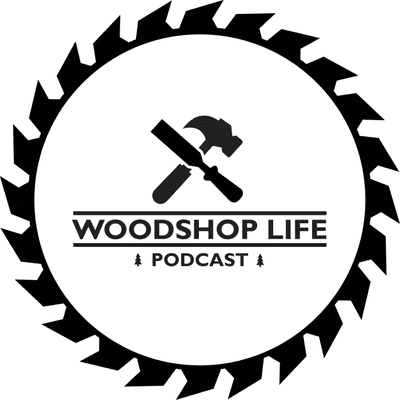
Woodshop Life Podcast
Podcast von Woodshop Life Podcast
Nimm diesen Podcast mit

Mehr als 1 Million Hörer*innen
Du wirst Podimo lieben und damit bist du nicht allein
Mit 4,7 Sternen im App Store bewertet
Alle Folgen
177 FolgenBrians Questions: Thanks for sharing your knowledge and opinions - and answering my previous questions. It's been a great help. My shop is in my single car garage, which I share with household storage. It has a very high ceiling. I recently got a good deal on a new Jet AFS-1000B Air Filtration System. (note: I do not have a dust collection system, as I try to do mostly hand tool work, but I do use power tools as needed. So there is plenty of dust). The question is: where to locate the device? The options are: 1. I have a shelf that is suspended from the ceiling and could test to see if it will support the Jet unit. 2. There is a metal storage cabinet that I can set it on, and attach to the wall (per Jet instructions). 3. Place it on the lower shelf of my Moravian style workbench. Attaching it directly to the ceiling is out, as it is too high, and I don't have ladders or scaffolding to get up there. The easiest is option 3 - on the lower shelf of the workbench. Will it be effective down there - about a foot off the ground? Or should I go for options 1 or 2? Thanks for any insight. David V. - Baltimore, MD Gentlemen, Thank you for taking the time out of your busy schedules to share your knowledge through the podcast. I’ve recently caught up on all the previous episodes and really look forward to the bi-weekly insights you provide. It’s been a tremendous help as I navigate the early stages of woodworking and material sourcing. I have a question regarding quality expectations when purchasing from regional hardwood suppliers. I’ve recently started buying from a distributor in the Texas/Oklahoma area that operates multiple warehouses. While I’m still relatively new to this type of procurement, I’ve noticed a gap between what I expected from a “select & better” grade product and what I actually received. My recent order was for cherry lumber—select & better, RW&L, averaging 6 inches wide, 9 feet long, and 15/16" thickness, graded 90/70+. The issue I encountered was significant end-checking and splitting—some boards had cracks extending 10 to 18 inches. Since the lumber (along with some maple and walnut) was bundled and strapped to a pallet, it wasn’t until I got home—over an hour away—that I realized the extent of the damage. I understand that some waste is always part of the equation, but I’m trying to get a sense of what’s considered “normal” for a premium grade. Should I have contacted the supplier once I noticed the issue? Or is it standard practice to inspect the order before it leaves the yard? I’d appreciate any guidance or rules of thumb you might recommend for handling situations like this. Thanks again for your time and for all the valuable information you share. It’s been a huge help. Best regards, Mark Guys Questions: I’m preparing to build a set of kitchen cupboards from white oak. The style will be Mission, with some Frank Lloyd Wright Prairies Style touches. I have several questions. I’m going to build some assembly tables. I don’t want hundreds of dog/hold-down holes in each, but I will probably drill a few. I’m wondering about 3/4” (the traditional North American standard) vs. 20 mm (a standard popularized by Festool, etc.). I know this isn’t a black and white choice, but could you share some thoughts on what one might consider before committing to one size vs. another. Darrin I frequently seem to struggle with keeping the countersink concentric concentric with the screw clearance hole. I have both the multi-flue countersink and the countersink with one diagonal hole but they both want to wander. I also have a tapered drill bit with set-screwed countersink. Maybe I should be trying harder to use that type. So my question is - do you have any suggestions for keeping the countersink centered on the clearance hole, and what is your preferred type of countersink. Steve Huys Questions: Hello guys, my name is Jim Rose. I live in north central Kansas and have a couple of completely different topics for questions. Before the questions, I wanted to say, thanks so much for an awesome podcast. I have been a listener since Brian came on board. In fact, the 1st episode I listened to was his 1st episode!!! First off, I have a question about beetle kill pine. I am currently building a new house and have purchased beetle kill pine to put on the walls and ceiling of a sunroom. My question is what finish should I use if any so that the blues and reds of the beetle kill pine will show the best and not change colors in anyway. I have seen different opinions on the internet ranging from a clear poly to nothing at all. Some have even said that a finish will change to colors which I definitely dont want. Not sure if this is true so thought I would the experts. Thanks in advance. Any suggestions/advice would be greatly appreciated. Thanks again, Jim Hey Fellas' as many say "love the podcast", I've learned a ton and look forward to more as I work my way through previous shows and keep up with new ones. The ask ... you've shared a fair amount regarding adhesive/glues including talking shelf life. How can we tell when an adhesive/glue has exceeded its shelf life and should be discarded and replaced? I mean knowing this is prior to using it and the project failing and pieces not sticking as needed. Thanks, Chris Hudson
This Episodes Questions: Brians Questions: What are the the most useful 3d prints for a woodworking shop. I often print out small pattern templates and fixtures for hole placement. Even storage solutions for various tools etc... what are your top suggestions? Josh Hi, let’s talk about working with laminated plywood. I just picked up about 25 sheets of 3/4”x 22”x6’ birch plywood that has Formica laminated on both sides from the free pile of a high volume cabinet shop. I want to encourage everyone to find local cabinet or mill work shops in your area and drive by them often! I do on my commute to and from work. What kind of design/construction considerations would you make when building cabinets with drawers for my garage using only this 3/4” plywood? It will be for my garage. I know it’s common to make drawers using thinner plywood but I’m not trying to spend money if I have to. how would you finish the edges? I’m going to make a blanket chest next, The laminate is a fancy textured walnut wood grain that actually looks pretty good. I currently don’t have a shop but have some hand tools and hand power tools like a router, circular saw with track, and a lot of imagination! With the help from your podcast I just recently purchased a biscuit jointer and a large (rather intimidating) 45 degree chamfer router bit. Haywood Guys Questions: Hi Guys, I’ve been listening to your podcast since the beginning and it’s by far the best. There’s not even a close second. My question is: I want to make shop sawn veneer. I have a band saw with 11” cut capacity, grizzly 8” jointer, a dewalt 735 thickness planner with a Byrd Shelix helical cutter head, but I don’t have a drum sander. I would like to end up with 1/16” cherry veneer that is 10” wide, but I’m not sure about the process to make it. Would the thickness planer be too aggressive to remove the bandsaw marks or would I need to purchase a drum sander? Also, after cutting a piece of veneer from the stock, do I need to reflatten the stock before cutting another piece of veneer. In general, I guess what I’m asking is given the set of tools above, how would you go about making veneer? Mike I am building a trestle table out of African Mahogany, more specifically Khaya. I am using 8/4 for the top and 12/4 for the legs. It is going to live on a jalousy window sun room that is not climate controlled in the state of Florida. What finishes do you guys recommend to use to help preventwood movement or warping over time, or is that just going to happen. David Huy's Questions: Hello Gents, This is a bit of a long winded question regarding aftermarket sliders for the table saw and how to best use them. I recently purchased an old Excalibur sliding table from my saw. This is an older model but from my understanding is almost identical to the current SawStop sliders, as SawStop took over the old Excalibur models (maybe this is incorrect or you have more insight?). I mounted the slider to the extension table on the left so I get the full size of the TS top and the slider fence is long enough to reach all the way to the blade. I figured that this way I get the best of both worlds, and I do have the space for it. My purpose for the slider was to help break down sheet goods, manage angled cuts on larger pieces, and to help cut miters on larger case panels. I've made a few cases in the past with mitered corners and running a long case panel on the TS to cut the miters is a bit of a pain. I was hoping that the slider would simplify that process as it would allow the long panel to move over the table smoothly while held square to the blade. Here is the kicker, the slider mounts on the left of the saw which is the direction that the blade tilts. In my mind, this creates a problem as I have to run the panel up-side-down, under the tilted blade, and the offcut would now be dropping on top of the blade where it will create a kickback situation. In general, I wouldn't run the piece "under" the blade when using a rip fence as it is trapped, but with the slider that's not really true. Seems problematic for the offcut but gives more accuracy and control on an otherwise unwieldy piece and may be worth rolling the dice. I figure that with the slider I have plenty of space to stand out of the firing line when that offcut goes flying, but it is probably smarter to avoid the situation in the first place.... What are your thoughts? How are others handling miters with a slider? It seems most folks in North America have them mounted on the left, and most of the saws tilt to that side. Bojan Hey guys I’ve been listening to lots of episodes of the podcast lately and find it very helpful me being a beginner. This will be a long one but here is the situation, I’m not far from Indianapolis so a couple of you understand the weather. Earlier this year I cut down a couple of trees from a family property before it got demolished for development. Trees were run through a local saw mill and kiln dried for me. When I picked them up from the local guys I brought the stack back and put it in a barn on the family farm. The barn is generally shut up but it is not conditioned. I do all my wood working in my basement at home that is conditioned. I’m getting ready to buy a used 8” jointer to help me handle all these boards. I will not be carrying a large jointer into the basement to do the work it will be at the farm where the wood is stored. Question is, with an unconditioned barn do you think it will be a problem to joint a few boards there, bring them back to the basement Woodshop and let them acclimate for a few weeks before proceeding to plane/cut up for projects? Would it be better to joint just a couple at a time as I’m going to need them or would jointing most of the boards and storing them unconditioned during the year and moving them to the Woodshop as needed be ok? Thanks for the podcast and all the info you guys provide. I’ve learned multiple things from you guys already and hope to continue learning more. Drew
Guys Questions Hey guys, I really love your show. My question is about food safe finishes. I do a lot of CNC carving and one of my favorite is deviled egg trays. The first couple I made for my wife I just finished with some butcher block oil, the composition of an egg Has something in it I think and it quickly turned the reliefs in the wood surface black. I talked to my sister-in-law who’s a chemical engineer and she told me that polyurethane once it’s cured would be fine for this. I have done a few with this and it seems to be holding up OK but I am curious what your guys thoughts are on the long-term effect of this. Most of my egg trays are made out of a butcher block style material that has lots of maple cherry ash a little bit of oak and various leftovers. Unfortunately, I can’t use walnut in my wood shop due to my wife’s tree nut allergy again guys. I really appreciate your podcast and look forward to listening to it. Albert Thanks for the great podcast, I learn something from every episode. I recently made a few band saw boxes for Christmas gifts. They are a good way to use up some offcut lumber and the family seems to appreciate something handmade. The 3 drawer box with a curved top and side (pictures attached) caused me a bit of trouble. Joni had preciously asked for a sideboard style cabinet to place between out living and dinning room areas. After 2-3 month we still hadn't found a design she liked....until she saw the curved band saw box. I quote "I love that design and want one like that only much bigger" My question is what suggestions do you have for making the curved top and sides, I am thinking the sides could be made using walnut plywood by cutting kerfs and bending the plywood over a frame but I am open to other ideas. The top has me stumped, I have made segmented arches for a table support but they were only 4" wide and I cut the arch on a band saw. That would not work for a wide dresser top. Approximate dimensions would be 30" -35" wide and 45- 55" tall and 20-22" deep Thanks in advance for you help DH I realize this isn’t a fine precision woodworking question, but I figure you guys have probably dealt with manhandling sheets of plywood. We have about 140 sheets of plywood that we need to put down on a floor. The median age of the guys doing this is somewhere between 65 and 70. Any suggestions for how to safely handle this many sheets of plywood to minimize strains and injuries ? Thanks, Mark Huys Questions Good Morning, I appreciate the podcast as I continue to learn its been a great resource, thank you! Quick background. I grew up watching PBS's Norm Abram and This Old House but never had much opportunity to learn wood working. As an adult I started learning both construction building and cabinet/furniture making helping others, reading and youtube etc. Starting in basement workshops with mostly benchtop tools. ~15 years into the journey I am starting to get a decent foundation. Recently I built a house with a planned garage workshop and have started outfitting it. Bones are there, lots of organization needed but I have now have 3hp grizzly table saw, bosch miter saw with large counter style station, 8" Grizzly jointer, 24" Grizzly Drum Sander, Grizzly Bandsaw and dust collector Planer still needs upgrading, have a Ridgid 13" but watching for a used 20" helical head. I have been busy chasing used deals! Also recently setup a 10'x10' popup tent with furnace filter setup tied into 12" exhaust fan as a spray booth, works great! Spraying with a Fuji mini mite 5 stage and PPS cup system. Space is 32'x32' when cars are out with 12' ceiling, in floor heat. Rural northern New York. Not a Rockler or similar store within a days drive but we have ample local sawmills to find solid wood if your willing to mill it and access to cabinet grade plywood delivered from suppliers. With this shop setup I am now building cabinets, furniture, trim, doors etc for our house. Starting in some areas I don't mind making some mistakes. Two areas that I am struggling to figure out: Finishes-your recent episode had some decent comments but I would love a thorough discussion on when you would choose a certain finish over another. In particular thinking of kitchen cabinets, vanities, built in's, kitchen table. High traffic areas. I have played around with conversion varnish from Woodwright. Seems like very durable stuff and I don't mind cleaning up with solvent but when is that necessary vs going with an easier to work with finish such as Sherwin Williams Emerald? Or middle ground lacquer??I do have Bob Flexners book but would love to hear your experiences/ opinions? If I do use conversion varnish how do you handle any touch ups? I have quite a lot of experience with airless on sheetrock so its not a huge jump but any suggestions on HVLP setups, when to use which tips etc. would be helpful. *Doors- I appreciated the conversation on doors recently. I have several very custom interior and exterior doors I want to tackle. I agree with your comments on buying pre hung for standard doors but between custom nature of what we want and because I just want to do it I am going to try to build my own. I want to buy the festool domino machines in time anyhow and I think that would be a good way to build the doors. I would enjoy hearing a conversation on specifics on how you would choose to build interior vs exterior doors, rail and style material vs. panel material vs jamb material. Is there a way to insulate the exterior door? Finishes? If you had the shop described above and both domino size machines what would you do? Thank you! Matt Wendig This one is a wood selection question. I am looking for a wood that has both good elasticity and shock resistance. I am building a Japanese makiwara board, which is a training tool that provides progressive resistance to striking force by the martial artist. The training board is about 55" tall, 5" wide and is tapered - so thick at the base and gradually tapers to the top. This allows for "flex" when the board is struck. In Japan - Japanese beech is typically used, but not readily available near me. I am thinking along the lines of Ash or Elm for my build. I appreciate your thoughts. Crafted Carpentry Tampa Hello gentlemen and thank you for the wonderful podcast. I live in the niagara region in Ontario Canada and for the last while I've been looking at upgrading my current table saw (Ridgid R4520) to something that runs on 220v for more power or possibly replacing it all together with a bandsaw. I have an oversized single car garage that houses my furnace, hot water tank, ATV, motorcycle, mechanical shop and woodshop so space is at a premium and that is the motivation to possibly do away with a table saw all together. I have a router table, mitre saw and track saw so I feel all the functions I may lose not having a table saw will still be covered by these tools plus I have a Ridgid job site table saw (R4518ns) I use for the odd job I do off site. I currently have an older 110v 14" king bandsaw that I find severely underpowered and that I want to replace anyways, so with the sale of my current bandsaw and table saw plus my current budget and with some convincing of my wife I'm thinking I'll have roughly $3000-3300CAD to buy either one bandsaw or have to use those fund to buy both a bandsaw and table saw. I am 6'4" and if my memory serves me correctly guy has said Laguna bandsaw tables are closer to the ground and I've quickly looked at some king bandsaw and craftex bandsaws but I'm not sold on them either. So my question question to you guys is, what would you do? Use all the funds on a bandsaw and if so which one and what type of blades should I purchase with it? Or split up the funds to purchase 2 machines and again which ones? And do you go new or used in both of those situations? Thank you ahead of time for taking the time to read and respond to my inquiry. James
This Episodes Questions: Brians Questions When making trivets, how to cut the grooves - when I cut mine I hogged out half the thickness of the wood in one pass. That led to some pretty rough cuts and gouges (i.e. scrap). I assume the answer is a router table with a lift, but of course I don’t have one YET. :) Also, what finish to put on a trivet (which is used for hot pans)? - different finish than a cutting board? Tung oil? Danish oil? I assume ’not’ ArmRSeal. Mark I’m preparing to build a set of kitchen cupboards from white oak. The style will be Mission, with some Frank Lloyd Wright Prairies Style touches. I have several questions. I have a SuperMax style cantilever 25-50 drum sander. Do you think that this is a feasible tool to level out the boards to remove the planer snipe? …and avoid having to cut 3” of the end of each piece? Darrin Guys Questions: Been enjoying your podcast through several projects. My background is homebuilding, but through my sawmill hobby and unwillingness to pay for overpriced garbage…I have found myself learning about woodworking. My question is about making doors. I have made one door so far using only groove cuts into the stiles’s and gluing the tenons of the rails and panels into these cuts. I don’t have much faith in the longevity of this door, but it’s been a year now. What is the traditional methodology for attaching the individual parts of a simple 3 panel door Should I just buy a domino and get it done… Also per your latest podcast episode, what is the best way to midi gate the wood movement at the joint of the rails/ stiles. As these joints are not small nor parallel. Sorry for the low brow question. Appreciate the knowledge. Lucas Hello esteemed woodworking gentlemen! Thanks for the amazing podcast and the contribution to the woodworking community. I’m seeking some general advice and hope you can help. I was recently watched a YouTube video where someone stated that a track saw blade should always be buried for the straightest possible cut. That made me wonder if I can be causing unnecessary blade deflection on my jobsite table saw and Dewalt miter saw. I often struggle achieving perfect 90 on those machines when crosscutting. As a hobbyist with limited shop time, setting up machines is pain but I understand its necessity. Can you speak on this blade deflection and are there any go to tricks that you have for ensuring your machines are set up properly? Thanks for any help you can provide.-Jose Huys Questions: A while back my wife and I bought and moved into a house with no dishwasher, then later purchased one after realizing how much not having one sucked. We made the mistake of assuming that we would be fine putting the dishwasher at the end of the counter, because we figured the top of the machine would look like a run-of-the-mill home appliance like a washer or dryer, rather than the monstrosity that it actually is. It is ugly. I think I actually recall my wife crying when she saw it, and not in a good way. Since then my loosely held plan has been finding a way to move or dispose of the contents of one section of our cabinets, then cut a section out of said cabinets big enough for the dishwasher to fit underneath. Recently, however, thanks in large part to your podcast, I have developed enough confidence in my woodworking skills to attempt a different idea. My thought is to make what is essentially an end cap or sidewall, which will match the existing cabinetry, anchor it somehow, and then place a new section of countertop between this end cap and the existing end cap of the cabinets. I would essentially be "extending" the countertop, thereby concealing top and visible side of the dishwasher. From what I can tell, all I would have to make, stain, and finish would be a cabinet side panel, a piece of trim to run along the bottom, and a partial face frame. So here come the questions: do you think this is doable, either generally or the way I am thinking? And what would be the easiest way to tackle this project? Note that I'm not particularly concerned over whether or not I use the same method of instruction as was used for the rest of the cabinetry. For example, I don't particularly care to use particle board with a veneer as the rest of the cabinets may have done if it would actually be easier or cheaper in this instance to just make the side panel out of a solid piece of wood. So long as it looks close, its fine with me. The applicable tools I can think of that I have at my disposal are a table saw with a crosscut sled, a compound miter saw, a jigsaw, fixed base router, various types of Sanders, a pocket hole jig, 15, 16, and 23 gauge nailers, and of course all of the basic hand tools. I would describe my skill level as approaching novice. Sincerely,Z achary T Owens Howdy yall, I'm wondering if you can recommend any smoke detectors or carbon monoxide detectors in the woodshop? I work out of a one car garage in Minnesota so have a gas heater to help me stay warm during our bitter winter months, but am also worried about oil rags possibly spontaneously combusting. When I first moved into the shop I tried installing a regular smoke detector however it kept on getting set off when I had excessive dust flying (thank you router). Is there anything that you know of on the market that won't get set off by dust but that I can keep my home protected and have a little more peace of mind? Thanks, Paul at Twin Lake Woodshop
This Episodes Questions: Brian's Questions: My neighbor gave me a beautiful maple root ball that is approximately 3' in diameter about 6 months ago. I am currently letting it dry for another 12 to 24 months. I'm thinking of eventually rough cutting it with a large reciprocating saw. The wood will be used for small boxes or knife handles. Am I crazy? Do you have any advice on dry times and using root wood? George Guy, I am making a bow front dresser and plan to use Blum Blumotion undermount slides for the drawers. However, I’m not sure how I should attach the front of the slide to the bottom of the draw, since the draw front will be curved. Any suggestions would be greatly appreciated. Also, the draws will be inset, but since the blumotion has a fair amount of flexibility (up/down and left/right) I am thinking aligning the draw fronts should be doable. But do you have any suggestions to make it as simple as possible? Finally I see Rockler has a “JIG IT” under mount drilling guide. Do you use this jig and do you recommend it? Thanks so much!!! Mike Guy's Questions: I live in Fishers, IN and am new to woodworking and was wondering how to find good places for hardwoods? It’s been pretty tough to find anything local without driving a decent distance to a mill on the west side of town. Chayse Bell I’m preparing to build a set of kitchen cupboards from white oak. The style will be Mission, with some Frank Lloyd Wright Prairies Style touches. I have several questions. How much planer snipe is too much? I have a Dewalt 13” model 735 benchtop planer. If I take a short board—say, two feet—and run it through once taking a 1/16 cut, I get 8/1000ths snipe. Is this to be expected? …or should I look at getting my planer serviced or maybe trading up. (The Laguna Tools PX16 planer looks amazing, but six times the money.) Darrin Huy's Questions: Thank you all for what you do. Like so many other woodworkers, I have accumulated quite a bit of wood through my own purchases and also from inheriting my fathers wood collection after he passed away. I would like to move it out of my two car garage workshop to free up space, and am considering building some sort of dry storage box to store it under a deck in my backyard. (I don’t have room for a large lumber shed). Thinking roughly 14 foot by 4 foot by 4 foot. This box would obviously be exposed to the weather as the deck is not sealed. What are your thoughts on this? And if you were to build this box, would you seal it relatively airtight or would you simply stack the lumber off the ground and put a piece of tin or something over the top to allow airflow. In the second example, I worry about snow, rain and bugs getting access to the lumber. Thanks in advance for your response. Eric in Lincoln Nebraska Hey gentleman, first of all, thank you for the amazing podcast and the fluff-free format. I’ve been a hobbyist woodworker for about 6 years and I’m at the point where I’m considering turning my hobby into a side job of sorts. My question is: in your opinion, what separates an amateur woodworker from a professional woodworker? Are there certain skills, techniques, or projects you learned that really elevated your confidence or status in the craft? Thanks again, and keep up the awesome content! Adrien from Toronto (Canada)























